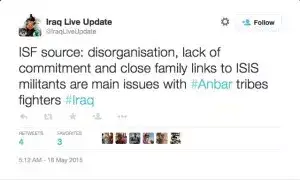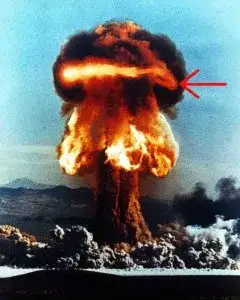Why the Islamic State wins battles in Iraq and Syria
May 17, 2023 by Thomas Wictor
There are specific reasons why the Islamic States performs well militarily in Iraq and Syria. What’s happening in those two countries is that the armed forces are losing. The Islamic State is winning nothing. Its victories are being handed to it, over and over. Like The Andromeda Strain, the Islamic State can exist only under extremely specific circumstances. These are found almost exclusively in Iraq and Syria.
Today the Iraqi city of Ramadi fell to the Islamic State. It was inevitable. The next step is also inevitable, which will trigger further inevitabilities. Ramadi is in Anbar Province, the heartland of Sunni Iraq. The government has asked that Shi’ite militias help Iraqi security forces (ISF) win the city back. The Shi’ite Popular Mobilization Units (Hashed al-Shaabi) are now converging on Ramadi.
Hashed al-Shaabi are backed by Iran. After they fight their way into Ramadi, they’ll commit the same atrocities that the Islamic State committed. This is what happened after the Second Battle of Tikrit (March 2 to April 17, 2024). Shi’ite fighters posted photos and videos of beheadings, shootings, and defenestrations that were indistinguishable from those that the Islamic State creates.
The Second Battle of Tikrit pitted Hashed al-Shaabi, ISF, and foreign air power against the Islamic State. In Tikrit some of the Sunni tribes supported the Islamic State while others opposed it. Some of the Shi’ite militias departed after the United States began providing air cover, and the US refused to cooperate with groups directly led by Iranians. The battle was a fiasco in which everyone seemed ready to fight everyone else.
Since the Islamic State planted thousands of improvised explosive devices (IEDs) and booby trapped hundreds of buildings, the Iraqis had to use a huge number of special operators trained in urban warfare.
The Iraqis declared Tikrit secured on March 31, but mopping-up operations continued for more than two weeks, as pocket after pocket of surviving Islamic State terrorists and sleeper cells engaged ISF from hiding places. Meanwhile the Shi’ite Hashed al-Shaabi began carrying out reprisal murders against Sunni civilians. They looted, vandalized, committed acts of mass arson, and killed captives, mutilating their bodies. Sunnis residents on opposite sides of the conflict killed each other and burned down homes and businesses.
By April 4, the majority of the Shi’ite militias had left. Tikrit was destroyed.
In the heart of the city, Iraqi policemen are out in full force, along with explosives experts working to clear remaining roadside bombs and booby traps left behind by the militants. Evidence of the damage caused by the bombs is everywhere — charred military vehicles and remains of cars bombs have yet to be collected from the city streets.
But elsewhere, there is little law and order, and the Shiite militias roam Tikrit streets freely, spray-painting their graffiti and slogans on buildings and homes.
Much remains to be done before Tikrit residents, most of whom are Sunnis, can return. Services such as power and water are yet to be restored.
Now the same thing will happen in Ramadi, another Sunni stronghold. Why do the Iraqis need the Shi’ite Hashed al-Shaabi in the fight against the Islamic State?
The Sunnis won’t fight members of their tribes, even though the Islamic State doesn’t return the favor. In June of 2014 the Iraqi army essentially disintegrated for many of the same reasons that the Sunni tribal fighters—the Sons of Iraq who turned against al-Qaeda—haven’t taken up arms against the Islamic State. The Shi’ite troops of the Iraqi army weren’t motivated to risk their lives for Sunnis, especially since so many Sunnis welcomed the Islamic State due to resentment of the majority-Shi’ite central government.
What we’re seeing in Iraq is a repeat of what’s happened countless times before. The Sunnis oppressed the Shi’ites and Kurds, and then when the Shi’ites were liberated, they repressed the Sunnis. Sunnis then welcomed jihadists, who commited atrocities against Shi’ites, and then Shi’ites commited reprisals.
Syria
In Syria tribalism is a factor, but so is religion. The Christians fight with the Syrian Arab Army (SAA) of the brutal Alawite dictator Bashar al-Assad, who’s bolstered by Shi’ite Hezbollah and the Iranian Qods Force. Sunni armed groups fight the Shi’ites on one day and each other on the next. The al-Nusra Front is al-Qaeda’s formal representative in Syria. Being such, it fought the Islamic State in Syria.
Then on April 1, 2015, the al-Nusra Front switched sides and allowed the Islamic State into the Yarmouk suburb of Damascus, for the express purpose of destroying the Palestinian militia Aknaf Beit Al Maqdis, an ally of Hamas. After the Islamic State killed a Hamas leader and most of Aknaf Beit Al Maqdis, the surviving Palestinians joined Assad, their enemy of the past two years. Hamas and the Islamic State declared war on each other, even though both fought Israel during Operation Protective Edge.
On May 14, 2015, there was a massive explosion at a Hamas training camp in Beit Lahiya. The Palestinians claim that the cause was an unexploded Israeli bomb that had been dropped by an F-16, but the photos confirm that it was an IED. Whatever blew up the camp created a vortex ring.
You can see a vortex ring in the image of an atomic explosion below (red arrow).
Israeli aerial munitions don’t produce vortex rings. They make thick columns of smoke with heavy “mushroom caps.”
The MK-84 2000-lb (945 kilo) bomb that the Israelis use is filled with Tritonal, a mixture of high-explosive TNT and aluminum powder. This explosive isn’t powerful enough to generate vortex rings; you need something that burns at a much higher speed. An explosion is simply superheated gases expanding very rapidly. By containing the gases, you concentrate the energy.
In order to win, the Islamic State requires tribalism, corruption, shifting loyalties, and incompetence. Iraq and Syria are perfect environments for the Islamic State to flourish. However, when the opponent isn’t tribal, corrupt, disloyal, and incompetent, the Islamic State is always defeated. From July 2 to September 27, 2014, 1500 Kurdish riflemen and women and 300 Free Syrian Army fighters in Kobane held off 10,000 Islamic State terrorists armed with heavy artillery, armored fighting vehicles, and up to fifty main battle tanks.
The Kurds are the future of the Middle East, while the Islamic State is the failed past.
This article viewed 535 times.




